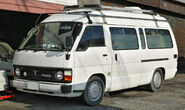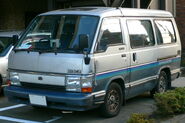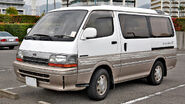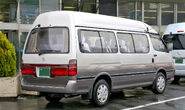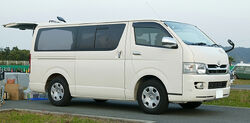 | |
| Manufacturer | Toyota |
|---|---|
| Production | Oct 1967–present[1] |
| Assembly |
Japan Thailand China South Africa Vietnam Egypt Sri Lanka Ovar, Portugal[2] |
| Class | Light commercial |
| Body style(s) | Pick-up, double cab, van, minibus |
| Platform | H-series |
The Toyota HiAce is a motor vehicle produced by the Japanese manufacturer Toyota. First launched in 1967, the HiAce has since been available in a wide range of configurations, including minivan (MPV) and minibus, van, pick-up, taxi, and ambulance.
First generation (H10; 1967–1977)[]
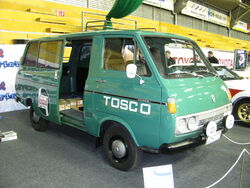 | |
| Production | Oct 1967–Jan 1977[1] |
|---|---|
| Platform | H10 |
Introduced in 1967, the Hiace was offered as cab-over pick-up, delivery van, and commuter vehicle. It was also called the Toyota Hiace Commercial in camper van configuration.
This type of Hiace is a rare model these days mostly because of weather wear and rust. Hiace vans originally sold on the European market have largely been exported to Africa where they are used as public transport vehicles.
Second generation (H20, H30, H40; 1977–1982)[]
 | |
| Production | Feb 1977–Jan 1982[1] |
|---|---|
| Platform | H20, H30, H40 |
The new Hiace of 1977 featured a more streamlined cab with single headlights. In addition to the petrol engine, a 2.2 litre diesel engine was offered in certain markets. New for the "20-40 series" Hiace was a double-cab pick-up, super-long-wheelbase van, and a high-roof Commuter.
After the third generation was released in 1982, certain variants of the second generation continued to be manufactured for several years. Like the first generation, this type is also very rare.
Third generation (H50; 1982–1989)[]
 | |
| Production | Dec 1982[1]–1989 |
|---|---|
| Platform | H50 |
A new Hiace van was launched in 1982, with the Hiace pickup truck coming later. The cab design was common to the bigger Toyoace light truck, though it had different frontal styling.
The van's model number contains various wheelbase specification information: 50 series vans have short wheelbases, 60 series have long, and 70 series have super long. The pick-up trucks are 80 and 90-series. The Toyota Mobile Lounge, displayed at the 1987 Tokyo Motor Show, is based on the Hiace high-roof Commuter. While the van and Commuter were redesigned in 1989, the pick-up lasted until mid-1990s. This was the last Hiace pick-up. Old design.
Fourth generation (H100; 1989–2004)[]
 | |
| Also called |
BAW BJ6490 Jiangnan JNQ6495 (China) Jinbei Haise |
|---|---|
| Production | Aug 1989–mid-2004 |
| Platform | H100 |
| Related |
Toyota Granvia JinBei Haise |
The fourth generation model appeared in 1989 and was available in standard wheelbase and long wheelbase variants; a Grand Cabin; standard wheelbase and long wheelbase van; long wheelbase and super long wheelbase high roof van. The latter shares a body design with the Commuter, which is a 15 seat minibus.
A range of engines were available in the 4th generation vehicles, ranging from 2 litre petrol engines to 3 litre turbo diesel engines. Most versions are rear-wheel drive, but part time or full time four-wheel drive versions were sold depending on specification level and market. The base model is typically the DX. Upmarket versions included CD, GL, and super GL models.
In the Philippines, the Hiace was first sold in 1995 with a diesel engine, getting revamped in 1997 as it went from business status to family van status. In 1999, the Hiace Grandia and 2.0 GL gasoline Hiace variants were launched, as well as the Hiace Commuter, a Hiace meant for business, and the Hiace was facelifted again in that year. In early 2001, the top-of-the-line 3.0 diesel Hiace Super Grandia was launched. All came with a standard 5-speed manual transmission. These variants were all sold until early 2005, with the next generation being launched in June of that same year. A special edition Hiace Super Grandia J (Japan edition) was also sold together with the RAV4 J and Revo J from 2002-2003.
This generation Hiace also remains popular in China, where it is still produced by at least three companies. These are exported to several markets, including Chile, and are also assembled in both Egypt (by Bavarian Auto Group) and Sri Lanka (as the Micro Car MPV J).[3]
Granvia (XH10)[]
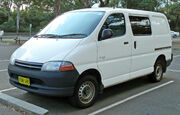
1995–2001 Toyota Hiace SBV (RCH12R) van (Australia)
Launched for Japanese market only in 1995, the Granvia is a semi-bonneted van, with the front wheels positioned in front of the front seats for better safety. The engine for Granvia is either a 2.4 L or 3.0 L diesel, or 3.4 L petrol. The Granvia spawned into the upmarket multi-purpose vehicles the Hiace Regius, the Grand Hiace and the Touring Hiace. The Granvia, Grand Hiace, and Touring Hiace are upmarket passenger vans only.
In Australia, the Granvia was sold as the Hiace SBV, alongside the fourth generation Hiace, and both were replaced by the new fifth generation model. The Hiace SBV sold in Australia (from 1999 to 2005) was designated RCH12R (short wheelbase) and RCH22R (long wheelbase) and was available only with 2.4 litre 2RZ-E petrol engine developing 88 kilowatts (118 hp) @ 4800 rpm and 200 newton metres (150 lb·ft) @ 3600 rpm and five-speed manual transmission. The smaller SBV Townace was powered by a 1.8 litre petrol engine.

Toyota Grand HiAce
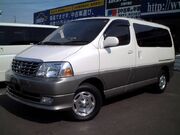
Toyota Grand HiAce
The Grand HiAce was based on the HiAce Powervan. Sales of the Grand HiAce started in Japan in 1999. Engines available were a 3.4-liter petrol and a 3.0-liter turbo diesel. This type was sold in Japan only until 2002.
Fifth generation (H200; 2004–present)[]
 | |
| Also called |
Toyota Commuter (Thailand) |
|---|---|
| Production | Aug 2004–present |
| Platform | H200 |
| Engine(s) |
2.5 L, 3.0 L D-4D diesel |
| Transmission(s) |
5-speed manual 4-speed automatic |
| Wheelbase | 2,570–3,110 mm (101.2–122.4 in)[5][6] |
| Length | 4,695–5,380 mm (184.8–211.8 in)[5][6] |
| Width | 1,695–1,880 mm (66.7–74.0 in)[5][6] |
| Height | 1,908–2,285 mm (75.1–90.0 in)[5][6] |
| Curb weight | 1,701–2,111 kg (3,750–4,654 lb)[5][6] |
The fifth-generation Hiace appeared in 2005 as a wide long-wheelbase wagon, wide super-long-wheelbase high-roof "Grand Cabin", long-wheelbase van, long-wheelbase high-roof van and a wide super-long-wheelbase high-roof van. In this generation the gear stick has been moved to the dash-board to enable easier movement in the cabin. Five-speed manual and four-speed automatic transmissions are available.
All of the models use a four-cylinder DOHC engine, in a variety of forms, a 1TR-FE 2000 cc or 2TR-FE 2700 cc petrol engine or a 2KD-FTV 2500 cc or 1KD-FTV 3000 cc D-4D turbo diesel engine.
Two of these engines are available in Malaysia, the 2.5 L turbo diesel, offered in a choice of panel van or window van; and the 2.7 L petrol, that comes only in the window van option.
The fifth-generation Hiace was launched in the Philippines on June 13, 2005, with D-4D variants, 2.5 diesel and GL Grandia, both with manual transmission. In 2006, the new top-of-the-line Hiace Super Grandia was launched, being the first ever Hiace in the Philippines with a standard automatic transmission.
The 2.5 and 3.0-litre turbo diesel engines have a maximum output of 75 kW at 3600 rpm and 80 kW at 3000 rpm respectively and maximum torque of 260 Nm at 1600–2400 rpm and 286 Nm at 1200–1600 rpm respectively. The 2.7 L petrol engine has a maximum output of 111 kW at 4800 rpm and a maximum torque of 241 Nm at 3800 rpm.
On Japan's list of the most commonly stolen vehicles the Hiace currently resides at #1. Because of a lack of a theft immobilizer, it is fairly easy to steal a Hiace, as opposed to much more valuable SUVs and sports cars, which have very technical theft deterrent systems.
Hiaces are also popular forms of transportation used by members of the entertainment business in Hong Kong.
References[]
- ↑ 1.0 1.1 1.2 1.3 "Toyota Vehicle Identification Manual", Toyota Motor Corporation, Overseas Parts Department, Catalog No.97913-84, 1984, Japan
- ↑ "Toyota Caetano Portugal: Assembly of Toyota Comercials (sic)". Grupo Salvador Caetano. Retrieved on 2011-02-04.
- ↑ "Micro Cars Limited". Microcars.lk. Retrieved on 2010-07-19.
- ↑ http://www.jiangnanauto.com/product_en.asp?action=productList&AlbumClass=1 JiangNan JNQ6495
- ↑ 5.0 5.1 5.2 5.3 5.4 "Toyota hiace kdh200r lwb". www.carsales.com.au. Retrieved on January 17, 2007.
- ↑ 6.0 6.1 6.2 6.3 6.4 "Toyota hiace trh201r lwb". www.carsales.com.au. Retrieved on January 17, 2007.[dead link]
External links[]
- Official Toyota Hiace site - UK (English)
- Hiace recalls
| ||||||||||||||||||||
| This page uses some content from Wikipedia. The original article was at Toyota HiAce. The list of authors can be seen in the page history. As with Tractor & Construction Plant Wiki, the text of Wikipedia is available under the Creative Commons by Attribution License and/or GNU Free Documentation License. Please check page history for when the original article was copied to Wikia |
